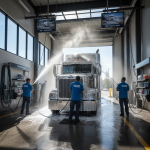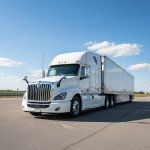In today’s fast-paced world, efficiency is everything. And when it comes to washing an 18-wheel tractor trailer 4 in a hand wash bay, finding the optimal headcount is the key to achieving maximum productivity. But how many workers does it really take to efficiently clean such a massive vehicle? In this article, we will delve into the science of washing tractor trailers, exploring the perfect balance between manpower and speed.
When it comes to hand washing a tractor trailer, having too few workers can result in a slow and time-consuming process, causing delays and reducing overall productivity. On the other hand, having too many workers can lead to inefficiency and wasted resources. By uncovering the ideal number of workers required, businesses can streamline their operations and maximize their profits.
Whether you own a trucking company or operate a wash bay, understanding the optimal headcount for washing an 18-wheel tractor trailer can make a significant impact on your bottom line. Join us as we unravel the secrets to achieving efficiency in motion and discover the perfect formula for a spotless and swiftly washed tractor trailer.
The importance of efficiency in hand washing
Efficiency is everything when it comes to hand washing an 18-wheel tractor trailer. In a world where time is money, reducing the time it takes to wash a vehicle can significantly impact a business’s bottom line. By maximizing efficiency, businesses can increase productivity, reduce labor costs, and improve customer satisfaction.
One way to improve efficiency is by optimizing the number of workers required to wash the tractor trailer. By determining the optimal headcount, businesses can streamline their operations and reduce the time it takes to wash a vehicle. This can translate into faster turnaround times, increased revenue, and improved customer satisfaction.
Efficiency is also important from a safety standpoint. Washing an 18-wheeler is a hazardous task that requires workers to climb ladders, use high-pressure washers, and handle cleaning solutions. By reducing the time it takes to wash the vehicle, businesses can reduce the risk of accidents and injuries.
Step-by-step process for hand washing an 18-wheel tractor trailer
Hand washing an 18-wheel tractor trailer is a labor-intensive process that requires a detailed and systematic approach. Here is a step-by-step guide to washing a tractor trailer in a hand wash bay:
1. Pre-wash the vehicle to remove loose dirt and debris.
2. Apply a specialized cleaning solution to the surface of the vehicle.
3. Scrub the surface of the vehicle with a soft-bristled brush.
4. Rinse the vehicle thoroughly with a high-pressure washer.
5. Apply a second cleaning solution to any remaining dirt or grime.
6. Scrub the surface of the vehicle again with a soft-bristled brush.
7. Rinse the vehicle thoroughly with a high-pressure washer.
8. Dry the vehicle with a clean, dry towel.
Analyzing the time required for each step in the washing process
To determine the optimal headcount for washing an 18-wheel tractor trailer, it is essential to analyze the time required for each step in the washing process. By breaking down the process into individual steps, businesses can identify bottlenecks and areas for improvement.
For example, the pre-washing step typically takes less time than the scrubbing step. Therefore, businesses may be able to reduce the number of workers required for this step. Conversely, the scrubbing step is the most time-consuming, so businesses may need to increase the number of workers for this step to achieve maximum efficiency.
By analyzing the time required for each step in the washing process, businesses can determine the optimal number of workers required to wash the vehicle in the shortest amount of time possible.
Determining the optimal number of washers based on efficiency
Once the time required for each step in the washing process has been analyzed, businesses can determine the optimal number of washers required based on efficiency. This number will vary depending on the size of the vehicle, the level of dirt and grime, and the equipment used.
For example, a smaller tractor trailer may require only two workers, while a larger vehicle may require four or more. A hand wash bay equipped with high-pressure washers and specialized cleaning solutions may require fewer workers than a bay with less advanced equipment.
Determining the optimal number of washers required is a critical step in achieving maximum efficiency. By reducing the number of workers required to wash the vehicle, businesses can reduce labor costs and increase productivity.
Reducing wash time through streamlining techniques
In addition to optimizing the number of workers required, there are several other ways to reduce wash time and increase efficiency. One way is to use specialized cleaning solutions that are designed to break down dirt and grime quickly. Another way is to use high-pressure washers that can clean the surface of the vehicle more quickly and effectively than traditional washers.
Streamlining techniques can also be used to reduce wash time. For example, dividing the washing process into smaller, more manageable tasks can reduce the time required for each step. Additionally, using a team-based approach, where workers are assigned specific tasks, can increase efficiency and reduce the time it takes to wash the vehicle.
Tools and equipment that can enhance efficiency in hand washing
The tools and equipment used in a hand wash bay can significantly impact efficiency. High-pressure washers, specialized cleaning solutions, and soft-bristled brushes are all essential tools for washing an 18-wheel tractor trailer.
Additionally, using a water reclamation system can help businesses reduce water consumption and lower their utility costs. Water reclamation systems capture and recycle water used in the washing process, reducing the need for fresh water and lowering overall water usage.
Case studies of successful hand wash bay operations
Several businesses have successfully implemented strategies to optimize efficiency in hand wash bay operations. For example, one trucking company reduced the time it takes to wash their vehicles by using a specialized cleaning solution that breaks down dirt and grime quickly. Another company reduced labor costs by using a team-based approach, where each worker is assigned specific tasks.
A case study conducted by a leading trucking company shed light on the importance of finding the right headcount. The company had been struggling with long wait times at their hand wash bay, which led to frustrated drivers and decreased customer satisfaction. By analyzing their current operations and experimenting with different headcounts, they were able to identify the optimal number of workers required to achieve efficiency in motion.
By studying successful hand wash bay operations, businesses can identify best practices and strategies for optimizing efficiency in their own operations.
Factors to consider when determining headcount for washing
Efficiency is everything when it comes to washing an 18-wheel tractor trailer in a hand wash bay. By optimizing the number of workers required, reducing wash time, and using specialized tools and equipment, businesses can increase productivity, reduce labor costs, and improve customer satisfaction.
When determining the optimal headcount for washing, businesses should consider the size of the vehicle, the level of dirt and grime, and the equipment used. By analyzing the time required for each step in the washing process, businesses can determine the optimal number of washers required based on efficiency.
Finally, by studying successful hand wash bay operations, businesses can identify best practices and strategies for optimizing efficiency in their own operations. By implementing these strategies, businesses can achieve efficiency in motion and uncover the perfect formula for a spotless and swiftly washed tractor trailer.
Conclusion and key takeaways
When it comes to hand washing a tractor trailer, having too few workers can result in a slow and time-consuming process, causing delays and reducing overall productivity. On the other hand, having too many workers can lead to inefficiency and wasted resources. It is crucial to strike the right balance to ensure a seamless workflow.
To determine the optimal headcount for washing an 18-wheel tractor trailer, several factors need to be considered. The size of the vehicle, the complexity of the cleaning process, and the available resources all play a significant role. Additionally, the experience and skill level of the workers involved can greatly impact the efficiency of the operation.




